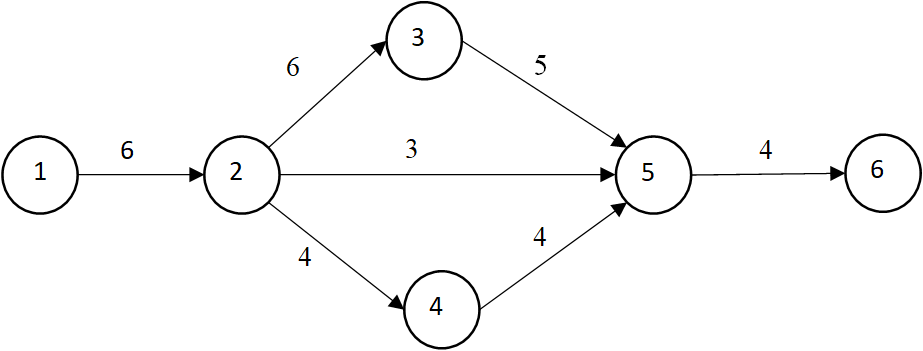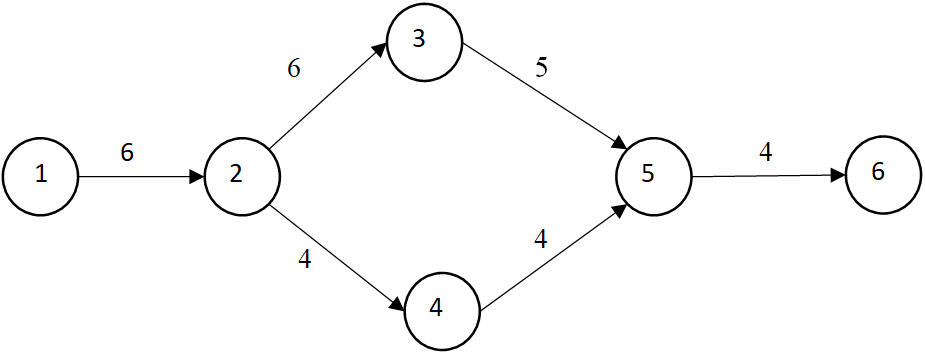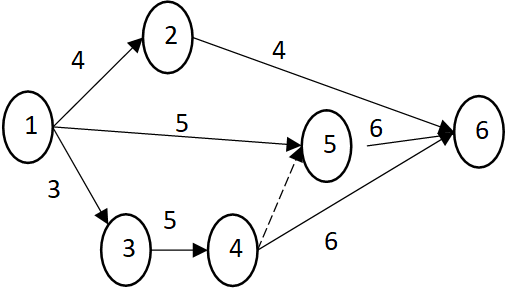This set of Industrial Management Multiple Choice Questions & Answers (MCQs) focuses on “CPM”.
1. What is the fullform of CPM?
a) Critical path method
b) Control path method
c) Critical programme method
d) Control programme method
View Answer
Explanation: CPM stands for critical path method. It is a network technique for planning and controlling the most logical and economic sequence of operations for accomplishing a project.
2. Find the critical path from the below-given network diagram. Each activity time is shown on its respective arrow.

a) 1-2-3-5-6
b) 1-2-5-6
c) 1-2-4-5-6
d) 1-2-3-5-2-4-5-6
View Answer
Explanation: A critical path is one which takes maximum duration to complete the project. The given network diagram can take three paths to reach the last event. They are as follows:
i. Path 1-2-3-5-6 with a duration of 21
ii. Path 1-2-5-6 with a duration of 13
iii. Path 1-2-4-5-6 with a duration of 18
Therefore, path 1-2-3-5-6 is the critical path.
3. Among the following network techniques, find the one that follows the activity-oriented approach?
a) CPM
b) PERT
c) Project
d) PERT and Project
View Answer
Explanation: CPM is an activity-oriented approach model. CPM has a one-time estimate. CPM considers cost as a controlling factor. CPM is a deterministic model.
4. Match the following.
p) Deterministic model i) Consumes time q) Probabilistic model ii) Does not consume time r) Dummy activity iii) PERT iv) CPM
a) p – ii, q – i, r – iii
b) p – ii, q – i, r – iv
c) p – iii, q – iv, r – ii
d) p – i, q – ii, r – iii
View Answer
Explanation: PERT is a probabilistic model. CPM is a deterministic model. A dummy activity does not consume time.
5. Among the following, find the incorrect statement.
a) CPM is a deterministic model
b) CPM is an event-oriented approach
c) CPM has a one-time estimate
d) CPM considers cost as a controlling factor
View Answer
Explanation: CPM is a deterministic model. CPM is an activity-oriented approach model. CPM has a one-time estimate. CPM considers cost as a controlling factor.
6. Consider the network diagram shown below and identify the critical activities. Duration of each activity is represented on the respective arrow.

i. Activity 1-2
ii. Activity 2-3
iii. Activity 3-5
iv. Activity 4-5
v. Activity 5-6
vi. Activity 2-4
a) iv, i, ii, iii
b) ii, i, iii, v
c) vi, i, iv, v,
d) ii, iii, iv, vi
View Answer
Explanation: From, the given network diagram, we can find that the path 1-2-3-5-6 is the critical path as it takes the maximum duration to finish the project. Hence, 1-2, 2-3, 3-5, and 5-6 are critical activities.
7. Who developed the Critical path method (CPM)?
a) Du Pont
b) Bell laboratories
c) IBM
d) Booz in collaboration with US Navy
View Answer
Explanation: Critical path method (CPM) is a project scheduling network technique developed by Morgan R. Walker of DuPont and James E. Kelley Jr. of Remington Rand. It is developed in the year 1958 for processing the needs of a chemical factory.
8. Find the project duration for the following network diagram.

a) 14 days
b) 8 days
c) 11 days
d) 10 days
View Answer
Explanation: The given network diagram has 4 paths to reach the last event.
i. 1-2-6
ii. 1-5-6
iii. 1-3-4-6
iv. 1-3-4-5-6
The paths 1-3-4-6 and 1-3-4-5-6 have the same time duration i.e. 14 days. The path 1-2-6 has 8 days and the path 1-5-6 has 11 days of project duration. The path with the maximum time duration is known as the critical path and the path duration is the project duration. There are two paths with the maximum duration and hence there are two critical paths.
9. Identify the correct statement.
a) CPM is used for R & D projects
b) CPM is an event-oriented approach
c) CPM follows three-time estimates
d) CPM is useful for repetitive and non-complex projects
View Answer
Explanation: CPM is a deterministic model. CPM is an activity-oriented approach model. CPM has only one fixed time estimate. CPM considers cost as a controlling factor. CPM is used for construction projects. CPM is useful for repetitive and non-complex projects.
10. How many critical paths are there in the below-shown arrow diagram?

a) Three
b) Two
c) One
d) Four
View Answer
Explanation: The given network diagram has 4 paths to reach the last event.
i. 1-2-6
ii. 1-5-6
iii. 1-3-4-6
iv. 1-3-4-5-6
The paths 1-3-4-6 and 1-3-4-5-6 have the same time duration i.e. 14 days. The path 1-2-6 has 8 days and the path 1-5-6 has 11 days of project duration. The path with the maximum time duration is known as the critical path and the path duration is the project duration. There are two paths with the maximum duration and hence there are two critical paths.
Sanfoundry Global Education & Learning Series – Industrial Management.
To practice all areas of Industrial Management, here is complete set of 1000+ Multiple Choice Questions and Answers.
If you find a mistake in question / option / answer, kindly take a screenshot and email to [email protected]
